#Pali Influence
Text
Exploring the Richness of Sinhala: Sinhalese Language of Sri Lanka
Unveiling the Captivating World of the Sinhala Language
The Sinhalese language is a linguistic gem with deep roots in Sri Lanka’s vibrant culture and history. With its melodious tones and ancient origins, this Indo-Aryan language has fascinated linguists and culture enthusiasts alike. This article explores the fascinating intricacies of the Sinhala language, exploring its development, its…

View On WordPress
#accessibility#Colloquial Sinhalese#Cultural Significance#Indo-Aryan Language#Language Access#Language Evolution#Language Services#Language Shift#LanguageXS#Linguistic Diversity#Literary Sinhala#Pali Influence#Sanskrit Influence#Sinhala Alphabet#Sinhala Interpretation#Sinhala Language#Sinhala Script#Sinhala Translation#Sinhalese Speakers#SOV Word Order#Sri Lanka Heritage#Sri Lankan Culture#Subject-Object-Verb#Syllabic Script#Vedda Language
0 notes
Text
Yes, the Blockout2024 is important but are you following Palestinian creators? Do you engage with content, products, art, etc made by Palestinians? I admit that even I personally have only recently begun intentionally engaging with Palestinian creators/activists/artists online so this is in no way a harsh criticism. Rather, I want non-Palestinians like myself to show more effort into uplifting Palestinians with the same fervor we distance ourselves from the celebs who at best do the bare minimum. We need to do better than the celebrities we are targetting. This is a great continuation of the efforts this trend and others like it are creating.
You can't just eliminate the voices who do harm from your circle of influence. You also have to amplify, enage with, and financially back Palestinians directly. No more politics telephone. No more listening to your fave white (and simply non-Palestinian) content creators who heard x from their fave white/non-Palestinian content creators who heard x from their faves and so on. Learn about Palestine directly from the mouths of Palestinians. Non-Palestinian allies are integral to this movement, but we need to center Palestinians in our education, conversation, and the ways we spend our money
V short list of starting points under the read more! Most on Instagram admittedly bc thats the only other social media I frequent
And please! Share your favorite Palestinian creators, celebrities, comedians, etc whether they're on this list or not!
Music
Amira Jazeera (pop singer, she reminds me a bit of Chappell Roan though I know v little of her aesthetic and musical style) on Instagram @/amirajazeera
Bashar Murad (almost got into Eurovision, wonder why he wasn't permitted 🙄 (eye-roll) and his new single "Wild West" i listened to on repeat for um. Far too long) on Instagram @/basharmuradofficial
Goods
Hirbawi (last Palestinian keffiyah store on Palestinian soil, beautiful designs as well as advocacy) on Instagram @/hirbawi
For Your Viewing Pleasure (Palestinian/indigenous-owned, women run clothing shop creates great pro-Palestine and generally left-leaning clothes and tote bags that make a political statement (do not wear easily recognizeable clothes like their products at protests!)) On Instagram @/foryourviewingpleasure
The Pali Project (Palestinian owned clothing, phone cases, mugs, etc. Go up to 5xl. Donate portion of proceeds to Palestinian causes) on Instagram @/thepaliproject
Darzah Designs (non-profit where all proceeds go directly to the women in Gaza who hand-stitch each piece and train more Palestinian women in safe working environments along the West Bank! The most intricate, indigenous Palestinian tatreez and Tahriri embroidery I have ever seen) on Instagram @/darzahdesigns
Activists in Palestine
Yusuf Abu Hattab (teen documenting daily life in Gaza) on Instagram @/reachyusuf
Hind Khoudary (reporter in Gaza, journalist for Al Jazeera) on Instagram @/hindkhoudary
Ali Jadallah (photographer in Gaza) on Instagram @/alijadallah66
Media and The Arts
Jenan Matari (producer & writer & activist. Has a reels folder on her Instagram where she spotlights talented Palestinian creators) on instageam @/jenanmatari
Dalia Elcharbini (art student with a print shop online filled with intricate, amazing art) on Instagram @/daliaeart
Luay Gharfai (chef who shares Palestinian recipes and gardening techniques) on Instagram @/urbanfarmandkitchen
Mariam (chef who shares The Most Delicious recipes I've ever had the pleasure of recreating! Those texas roadhouse rolls copycat recipe... Her desserts? To die for) on Instagram @/mxriyum and on her food blog where her recipes are written on mxriyum . com (broken up so its not a link)
#palestine#palestinian artists#music#art#support small artists#support small business#cooking#recipes
13 notes
·
View notes
Text
Heaven in Touhou and its Relation to Buddhism
I've been reading a lot about Buddhism lately, and I'm finally coming to an understanding of how that informs the depiction of Heaven in Touhou Project. First, I will summarize some of the official descriptions of Heaven within Touhou, and then cover the elements of Buddhist cosmology that influenced those depictions.
Some notes on terminology. I prefer the Sanskrit forms of words to Pali when possible. Exceptions are when the Pali form is overwhelmingly used. I will give the Chinese/Japanese translations of Buddhist terminology in parentheses. Translations of Japanese text from Touhou is my own original translations rather than taken from the wiki or other fan translations.
Finally, a warning. I am not a Buddhist and am approaching the religion from an academic perspective. Therefore, I will not endorse the religion, nor will I explicitly attempt to refute it. Take everything in this post as a summary of Buddhism based on my own readings, and check out the references as they are written by actual scholars who study Buddhism, or practicing Buddhists.
Heaven in Touhou

Heaven in Touhou is constantly referred to as 天界、the first character meaning "heaven" or "sky," translating the Sanskrit word deva meaning "god," and the second character meaning "world" or "realm," translating the Sanskrit word loka meaning "world" in most situations.
Most of what we know about Heaven comes from the story of Scarlet Weather Rhapsody. In general it seems to be based on the Buddhist concept of the devaloka, but is not equivalent to it and not completely accurate to Buddhist cosmology.
In Tenshi's story in SWR, Tenshi states:
天界は成仏した霊が住む処
"Heaven is a place where spirits who have reached nirvana live." As we will see, this detail contradicts with established Buddhist dogma, and is something that serves to distinguish Touhou's Heaven from those of Buddhism.
Heaven being the destination for souls released from saṃsāra has consequences important to the world of Touhou. In a footnote to Yuyuko Saigyouji's article in PMiSS, Akyuu describes the situation in heaven:
*4 天界は輪廻転生を断ち切った者が行くので、現在飽和状態である。
"Since heaven is the place that individuals who have broken free from saṃsāra, it is currently overcrowded." This is backed up by Yukari's route in SWR, where Yukari states the same thing, as well as Youmu's route.
Denizens of Heaven are referred to as celestials(天人)in the fan translations of Touhou, as well as in most translations of Buddhist literature. According to Akyuu in PMiSS,
天人は修行を積んだ仙人が、不老不死を得て生きたまま天界に行った天人と、死後、成仏して天界に行った天人が居る。
"Celestials are either hermits who have achieved immortality and ascended to Heaven, or to those who reached nirvana and went to Heaven after death."
Akyuu also describes the location of Heaven more precisely:
天界は雲の上に存在すると言われるが、本当はそうではない。冥界の中に存在し、冥界の遥か空の上に存在するのである。
"It's said that Heaven exists in the clouds, but in truth this is not the case. It actually exists in the Netherworld, and more precisely is located far above the sky in the Netherworld."
The last important detail about Heaven we are provided is the existence of a location within it known as bhavāgra or 有頂天 (uchouten). In Yukari's story in SWR, this is said to be where Tenshi lives. In fan translations you will often see this spelled Bhava-Agra or Bhavaagra.
Heaven in Buddhism
Buddhist cosmology is complex and differs from sect to sect. I will follow the description of Gethin, which is based on the Nikāyas and the Abhidharma [2]. The Three Realms doctrine is also expounded by Yogācāra [4]. The jargon will be coming fast here, so please turn to the glossary at the end of the post if needed. See [1] for a fuller picture, as I will omit details for the realms and worlds that aren't considered heavens.
Three Realms and Six Paths
The three realms or dhātus are
Ārūpyadhātu or Arūpaloka(無色界)- The "formless" realm, a non-corporeal realm where one who has attained an arūpa āyatana is reborn.
Rūpadhātu or Rūpaloka (色界)- A realm of forms, where beings who have attained dhyāna are reborn.
Kāmadhātu(欲界)- The realm of desire. This includes the Six Paths where beings are reborn based on their karma.
The Six Paths (confusingly also called realms) are
The Path of Deva(天道)- Rebirth as a deva, who lives a life of pleasure but is unable to practice the dharma due to being distracted by their pleasurable life.
The Path of Humans(人間道)- Rebirth as a human being, who experiences both pleasure and suffering.
The Path of Asura(修羅道)- Rebirth as an asura, a demi-god who experiences pleasure but also constantly fight among themselves or against the devas.
The Path of Beasts(畜生道)- Rebirth as a non-human animal, considered to consist of more suffering than life as a human.
The Path of Preta(餓鬼道)- Rebirth as a preta, who live in constant agony experiencing extreme hunger and thirst.
The Path of Hell(地獄道)- Rebirth in a naraka, a hell where one is tortured until one's negative karma is exhausted.
In non-Japanese sources, I think it's common for the Asura realm to be placed above the Human realm. Only the Path of Deva is considered to be a kind of "heaven," but sometimes the Asura and Deva Paths are combined to give a Five Path system.
Whether the three realms are referring to psychological states or actual locations (or in the case of Ārūpyadhātu, non-locations) one can be reborn in is debated in the academic literature I could find [3]. At the very least, the Six Paths are often described as physical locations, e.g. the devas have their own world they live in which is separate from that of humans, but some of the worlds can overlap. Humans and preta experience the same world, but the way they perceive it is vastly different.
The highest abode of the formless realm is bhavāgra, sometimes translated as "the peak of worldly existence" or "the peak of cyclic existence" [5]. It is the highest mental state one can attain; to go any further is to reach nirvana. In Touhou, bhavāgra is the peak of Heaven, and where Tenshi Hinanawi lives.
Overall, Touhou simplifies the cosmology of Buddhism for its depiction of Heaven. The Form and Formless realms are combined with the Deva path, and Heaven is reinterpreted as the rebirth destination for beings who reach nirvana. Unlike in Buddhism, where one can only enter a heaven by being reborn in one, in Touhou one can enter Heaven while alive through ascetic (hermit) practices after gaining immortality. This is a Taoist influence, where the Chinese concept of tian(天)is combined with the kinds of heaven in Buddhism.
The complex psychological description of meditative states, the dhyānas and arūpa-āyatanas, are not mentioned in Touhou (at least not when it comes to Heaven as a location). However, bhavāgra, the highest of the arūpa-āyatana, is present as a physical location within Heaven. The Japanese word for bhavāgra, 有頂天、can also describe a state of ecstasy, so it's likely ZUN would be more familiar with that word than the other arūpa-āyatanas.
I might do more of these posts in the future. I need to look more into Taoism and the Chinese influences that appear in the depiction of Heaven, as I know little of them. I avoided mentioning the Dragon Palace for this reason. I could also write about Hell in Touhou, since its structure is a lot more developed than Heaven.
Glossary
bhavāgra(有頂天)- an alternate name for the "Sphere of neither perception nor non-perception"(非想非非想処). The highest plane of the Formless Realm(無色界)、a state where beings who reached the fourth formless dhyāna (arūpa-āyatana) are reborn in. In Touhou, a physical location in Heaven.
devaloka(天界)- a world of devas (Gods), i.e. heaven. In Touhou, a physical location above Gensokyo where beings who achieve nirvana are reborn.
dharma(法)- in this essay, primarily refers to the teachings of the Buddha and Buddhist belief more generally.
dhyāna(禅定)- meditation to achieve a mental state of concentration, equanimity, and awareness, or the resulting mental state. Beyond the four rūpa dhyānas are the four arūpa-āyatana. Attainment of these eight levels determines one's rebirth in either the Formless Realm or the Realm of Forms.
karma(業)- an action or its effect. In Indian religions, including Buddhism, karma is a cosmic principle whereby actions and their intents produce positive or negative results in this life or even after rebirth.
naraka(奈落)- a world in Hell, where those who performed bad deeds in a past life are reborn and tortured until they have exhausted their negative karma and can reenter saṃsāra.
nirvana(涅槃)- the cessation of the activity of the grasping mind, which results in liberation from suffering and saṃsāra.
preta(餓鬼)- a being that undergoes suffering greater than that of humans, being always hungry and thirsty. Often translated as "hungry ghost." Rebirth as a preta is a result of committing wicked acts in a previous life that don't merit rebirth in a Hell.
saṃsāra(輪廻転生)- the cycle of death and rebirth, where individuals are reincarnated into one of Three Realms, including the Six Domains of the lowest realm.
References
Gethin, Rupert. The Foundations of Buddhism. OUP Oxford, 1998.
Gethin, Rupert. "Cosmology and Meditation: From the Aggañña-Sutta to the Mahāyāna." History of Religions 36, no. 3 (1997): 183-217.
Burley, Mikel. "Conundrums of Buddhist Cosmology and Psychology." Numen 64, no. 4 (2017): 343-370.
Woo, Jeson. "On the Yogic Path to Enlightenment in later Yogācāra." Journal of Indian Philosophy 42 (2014): 499-509.
Higgins, David. "A Reply to Questions Concerning Mind and Primordial Knowing." Journal of the International Association of Buddhist Studies (2011): 31-96.
Touhou Sources
Perfect Memento in Strict Sense - Yuyuko Saigyouji
Perfect Memento in Strict Sense - Celestial.
Scarlet Weather Rhapsody (SWR) - Yukari's scenario
Scarlet Weather Rhapsody (SWR) - Tenshi's scenario
39 notes
·
View notes
Text
Early morning linguistics headcanon hours:
Common Varchaasi is a primarily Austronesian language (with some Sanskrit and Pali influence) which has picked up some elements of the proto-Mongolian language spoken in the Khanate over centuries of trade. The religious register of the language has significantly more Sanskrit-based vocabulary, and some grammatical artifacts from its Fall (fossilised in texts) no longer present in modern Varchaasi. Religious Varchaasi is primarily a written language, but it is sung in prayer.
#feel free to yes and me#or even 'i completely disagree and think __'#i'm just having fun in my corner#and there's so much cool linguistic potential across the neath#varchas
8 notes
·
View notes
Text
1. Ge’ez Script
Ge’ez language is now generally only used as a liturgical language for Ethiopian Orthodox Church. Ge’ez script is used in Amharic, Tigrinya, Bilen, etc.
The Ge’ez script is an alphasyllabic writing system. The syllabary today has 26 consonantal letters with several forms vowel are diacritic marks fused to the letter.
2. Quipu
Incan Empire quipus were recording devices made from string. They were used to record mainly numerical data, such as taxes, census numbers, and calendrical information
These data were recorded onto the string in a series of knots of different types, each denoting different numbers.
3. Tengwar
J.R.R Tolkien writing systems created by J.R.R Tolkien an avid linguist who added his expertise in the field to his creative works of fiction.
One of several writing systems for the languages used in Middle Earth.
4. Rongorongo
Found on Rapa Nui AKA Easter Island. Rongorongo is a series of glyphs about which we know virtually nothing.
5. Sinhala Script
Used by the Sri Lankans to write the Sinhalese language, as well as the holy languages of Pali and Sanskrit, the Sinhala script is easily one of the most beautiful scripts in the world. It is used by the 16 million Sinhala speakers of Sri Lanka.
The Sinhala script is a syllabary and is written from left to right.
6. Classical Mongolian Script
This writing system enjoyed prominence throughout Mongolia for over 700 years until it was supplanted by the Cyrillic script, a result of being within the Soviet sphere of influence.
Invented by a Uyghur scribe by the name of Tata-Tongoone. Classical Mongolian of the few systems to be written vertically and left to right instead of right to left.
7. Nüshu
Used in Jiangyong County in Hunan Province in Southern China. Because of strict laws of patriarchal Confucianism that forbade women from doing many things.Women invented a writing system that they could claim as their own and as a way of rebelling against the patriarchal system
Nüshu was born and was used for writing personal diaries and letters between close female friends. It has 600 to 700 symbols represent a phonetic syllable.
#language#history#linguistics#writing script#list#international#geez#quipu#Mongolian#sinhalese#conlang#rongorongo script
7 notes
·
View notes
Text

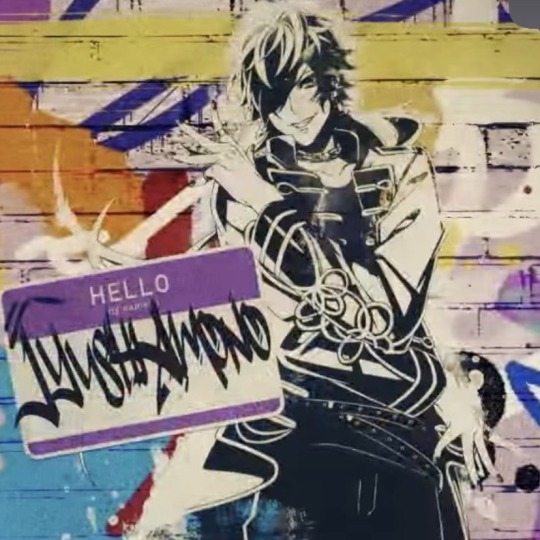

bat’s signature thoughts except i’m just spitting straight bs lmao
📿:
compared to his team’s pen calligraphy influences, kuukou picked up a marker and went to town lol
his brush calligraphy experience jumped out tho on those ‘h’ and ‘k’ very bold strokes
kuukou’s ‘u’ is actually derived from ‘प’ which is a sanskrit character found in the sanskrit version of his last name so kuukou’s multilingual with like hindi and/or pali
the six arrows on kuukou’s are symbols of the six perfections, core traits an enlightened person must have
🌙:
the extra dashes jyushi adds to his letters, like the ‘o’s for example, are similar to the dashes in the bb logo jyushi is now the newest bb member
the way jyushi writes his ‘a’s look like a tail with a hook, so a devil’s tail, devil’s flower release confirmed
the strokes above the jyushi’s j actually symbolise amanda, those lines combined with the ‘j’ make up an umbrella shape and it’s not jyushi providing shelter from this storm this rain as his microphone symbolises, it’s just amanda who is also on his umbrella lmao
⚖️:
his pen calligraphy with old english influences says that with his juvenile interest in magic and black and white striped socks, hitoya was witchcore as a teen
he underlined the guni on his last name, the kanji that means nation, so he’s putting on emphasis that this is for the nation guys lol
he dotted his ‘i’s like diamonds so like, diamond eyes hitoya’s eye colour confirmed
or that he’s either a deftones fan or a shinedown fan. or both lol!!!!!!!!
#this is vee speaking#lol what???? some of these sound legit????#idk what you mean i was not serious about any of these lol#tho lol if you told me that kuukou casually spitting out indian versions of his buddhist gods and sutras#while also wearing sanskrit on his clothes means he at least has to have studied pali and or hindi well!!!!!!#who am i to say otherwise lol!!!!!!#am i pushing weathering the storm imagery with jyushi’s umbrella mic again????? nope that’s a coincidence 🤗🤗🤗#the devil’s flower thing???? that was just a threat made lightheartedly lol!!!!!! 🤗🤗🤗(😡😡😡)#boy it would be nice if the guidebook stated what everyone’s eye colour is!!!!! grey hazel is a mouthful and diamond kinda sounds cooler!!!!#so it’d be great if kr could define that before i start getting ideas or something lmao!!!!!
18 notes
·
View notes
Note
do felix and palis have a favorite genre of music?
admittedly i'm nothing of a music expert, and these characters also live 350+ years in the future so i think the genres would look a bit different by then. but i would describe felix's tastes as closest to industrial, nu metal & metalcore, prog rock, and dubstep/adjacent electronic genres! (relatedly, while there's a laundry list of other influences, my main inspiration for his fashion sense is the mall goth subculture.) palis' tastes are a bit more eclectic, along the lines of punk, noise, EDM, hyperpop, electroswing, and disco. (unlike felix, she doesn't dress the part, but she loves going to raves and basement shows. just don't let her super-uptight parents know that...)
2 notes
·
View notes
Text
Tiptoeing through the “New Beginnings” guest cast
Bar Paly as Anastasia "Anna" Kolchek
Back from visiting the wedding planner in "Shame" in early March.
Ava McCoy as Jordyn Rountree
Last seen hanging with her brother, Fatima and FBI Special Agent Summer Morehurst in late March's "Sleeping Dogs".
Richard Gant as Raymond Hanna
While mentioned often, this is Raymond's first appearance since the Hanna family reunion in "Dead Stick" last fall.
Written by: Kyle Harimoto & R. Scott Gemmill
Kyle Harimoto wrote "Omni", "Merry Evasion", "Chernoff, K" (season six finale), "Command and Control" as episode 150, "Granger, O.", "Ghost Gun", "Kulinda", "767", "Se Murio El Payaso", "Assets"/"Liabilities", "Venganza", "Superhuman", "One of Us", "Let Fate Decide" (season 11 premiere), "Decoy", "Answers" , "Watch Over Me", "Cash Flow", "Fukushu", "Bonafides", "Come Together" (season 13 finale) and "Of Value". He co-wrote "Three Hearts", "Leipei", "Humbug", both ends of the "Matryoshka" two-parter (part one with Gemmill), "Smokescreen" part two, "Searching", "A Fait Acompli", "A Tale of Two Igors" (season 12 finale, with Gemmill) and "Best Seller".
R. Scott Gemmill wrote/cowrote "The Only Easy Day", "Brimstone", "Breach", "LD50", "Found", "Borderline", "Absolution", "Archangel", "Tin Soldiers", "Impostors", "Cyberthreat", "Honor", "The Watchers" and both sides of the NCIS Los: Angeles/Hawaii Five-0 "Touch of Death" episodes, "Recruit", "Free Ride", "Wanted", "Ravens and The Swans", "Impact", "War Cries", both ends of the "Deep Trouble" season five finale/season six premiere, "Inelegant Heart", "Praesidium", "Traitor", "Active Measures" (season seven premiere), "Blame It On Rio", "Internal Affairs", "Matryoshka" part one (with Harimoto), "Talion" (season seven finale), "High Value Target"/"Belly of the Beast" (season eight premieres), "The Queen’s Gambit", "Under Siege", "Unleashed" (season eight finale), "Party Crashers" (season nine’s premiere), "This Is What We Do" (episode 200), "Các Tù Nhân", "Goodbye Vietnam", "Ninguna Salida" (the season nine finale), "Hit List", "Asesinos", "Till Death Do Us Part", "Choke Point", "The Guardian", "Hail Mary", "Kill Beale Vol. 1", "Alsiyadun", "Fortune Favors the Brave", "The Bear" (season 12 premiere), "Angry Karen", "Love Kills", "Russia, Russia, Russia", "The Noble Maidens", "A Tale of Two Igors" (season 12 finale with Harimoto), "Subject 17" (season 13 premiere), "All The Little Things", "MWD", Work and Family", "Game of Drones" and "A Long Time Coming".
Directed by: John P. Kousakis directed "Imposters", "Sacrifice", "San Voir" part one, "The Fifth Man", "Parley", "Inelegant Heart", "Chernoff, K." (season six finale), "Active Measures", "The Long Goodbye", "Talion" (season seven finale), "Glasnost", "Unleashed" (season 8 finale), "Party Crashers" (season nine premiere), "This Is What We Do" (episode 200), "Goodbye Vietnam", "Ninguna Salida" (season nine finale), "The Guardian", "High Society", "A Tale of Two Igors" (season 12 finale), "Under the Influence", "Genesis", "Come Together" (season 13 finale), "A Farewell to Arms", all of the Afghanistan scenes from "Iron Curtain Rising" to "Zero Days" in season five and all of Kensi’s injury/recovery storyline scenes from "The Queen’s Gambit" to "Sirens" in season eight.
12 notes
·
View notes
Text
𝗠𝗘𝗗𝗜𝗧𝗔𝗥𝗘

Forse è una delle soluzioni migliori che si possa utilizzare per non perdere il lume della ragione, per non smarrire quella piccola capacità che rimane di ragionare per salvarsi da una vita caotica e piena di difficoltà.
Ho fatto alcuni percorsi di meditazione, di seguito per condividere, ve ne elenco alcuni che potreste utilizzare per trovare il vostro equilibrio. Perché alla mia domanda per avere il Bonus Psicologico l'INPS mi ha risposto con un due di picche. Quindi ho ripiegato sulla meditazione.
- 𝗟𝗼 𝗦𝘁𝗼𝗻𝗲 𝗕𝗮𝗹𝗮𝗻𝗰𝗲
è una disciplina mentale rivolta a porre in equilibrio pietre e massi di varie forme sfruttando solo la forza di gravità. Ottima disciplina per chi vuole metterci delle pietre sopra a varie situazioni. Se sarete abili a forza di metterci una pietra sopra potreste anche costruirvi una bellissima dimora.
- 𝗠𝗲𝗱𝗶𝘁𝗮𝘇𝗶𝗼𝗻𝗲 𝗭𝗲𝗻
si tratta di un'antica arte usata per primi dai gatti, la loro abilità di cacare nella lettiera disegnando linee continue o geometriche è diventata anche di utilizzo dell'uomo. Bevete lentamente il vostro tè, rastrellate la sabbia con delicatezza e mano ferma. Aspirate l'aroma degli incensi. Poi dopo tutto questo siete pronti a uscire e farvi prendere a sberle dalla vita, ma voi siete Zen, e non ve ne fregherà più un cazZen.
- 𝗠𝗲𝗱𝗶𝘁𝗮𝘇𝗶𝗼𝗻𝗲 𝗧𝗿𝗮𝘀𝗰𝗲𝗻𝗱𝗲𝗻𝘁𝗮𝗹𝗲
la meditazione trascendentale si basa sulla ripetizione per alcuni minuti, due volte al giorno, di uno specifico suono (mantra), che permette alla mente di raggiungere uno stato naturale di "consapevolezza senza oggetto" o "senza pensieri" chiamato "trascendenza". Non fate i furbi, non valgono le "madonne" né i "porconi". Per quanto mi riguarda il mio suono è "Pizzaah". Vi assicuro che come trascende nello stomaco poi sarete senza pensieri.
- 𝗠𝗲𝗱𝗶𝘁𝗮𝘇𝗶𝗼𝗻𝗲 𝗩𝗶𝗽𝗮𝘀𝘀𝗮𝗻𝗮
che nell'antica lingua indiana pali significa "vedere le cose in profondità, come realmente sono". Ora. Prendetevi circa venti minuti e guardatevi tutti questi VIP che sono gli influencer, i politici e altri personaggi noti. Guardateli bene con occhio distaccato e senza coinvolgimento emozionale alcuno. Vi accorgerete che questi VIP non sono sani (di mente), da qui Vipassana Micatanto. magari la finirete di farvi prendere per il culoSan.
- 𝗠𝗲𝗱𝗶𝘁𝗮𝘇𝗶𝗼𝗻𝗲 𝗠𝗶𝗻𝗱𝗳𝘂𝗹𝗻𝗲𝘀𝘀
gli occhi dovrebbero essere chiusi e la concentrazione della persona deve essere rivolta solo alla respirazione e ai movimenti effettuati dall'addome durante le inspirazioni e le espirazioni.
Non sentite il respiro? Probabilmente siete morti e non ve ne siete accorti. Respiro affannoso? Facile che lo stiate facendo mentre il vostro partner vi sta cazziando. In questo caso rispondere "blll-blll-blll" facendo vibrare la lingua tra le labbra potrebbe dare grandi soddisfazioni.
- 𝗠𝗲𝗱𝗶𝘁𝗮𝘇𝗶𝗼𝗻𝗲 𝗛𝗼'𝗼𝗽𝗼����𝗼𝗽𝗼𝗻𝗼
ecco questa meditazione si deve fare recitando un mantra. Si dice che alcuni sbagliando la pronuncia si siano ritrovati un Hippopotamus (ippopotamo), chi Ponypopizza con il tipo di Deliveroo che suona alla porta. Vi suggerisco di iniziare questa meditazione oponopoco alla volta.
- 𝗠𝗲𝗱𝗶𝘁𝗮𝘇𝗶𝗼𝗻𝗲 𝗰𝗮𝗺𝗺𝗶𝗻𝗮𝘁𝗮
la parte più difficile di questa pratica di meditazione è convincere le vostre gambe a camminare, che lo devono fare per il vostro bene.
Usate frasi del tipo "Potrei chiedervi di correre, invece vi sto chiedendo solo di camminare. Ma dove lo trovate uno buono come me?". Anche se dovesse fare caldo non demordete, convincete le vostre gambe che state per andare il un locale climatizzato piena di gnagna o gnoccoloni o alcol a seconda delle vostre priorità.
- 𝗠𝗲𝗱𝗶𝘁𝗮𝘇𝗶𝗼𝗻𝗲 𝗞𝘂𝗻𝗱𝗮𝗹𝗶𝗻𝗶
aprite il vostro chakra interiore, non esteriore però. Che prenderlo nel chakra è un attimo. Potrete trovare la vostra consapevolezza se vi applicate bene, vedere il vostro chakra interiore aperto svelerà ai vostri occhi situazioni tipo: "ma potevo esse più cojone?". Poi non rimaneteci male. La meditazione Kundalini può risolvere al massimo il 50% dei vostri problemi, vi consiglio quindi di farla due volte. Se la matematica non è un'opinione.
- 𝗠𝗲𝗱𝗶𝘁𝗮𝘇𝗶𝗼𝗻𝗲 𝗗𝗶𝗻𝗮𝗺𝗶𝗰𝗮
la meditazione dinamica è la meditazione di Osho più essenziale e più conosciuta. In pratica se doveste partecipare a un Rave Party con musica HardCore Techno arrivate già allenati. Non valgono gli attacchi epilettici all'Agenzia delle Entrate, come non valgono le convulsioni quando ricevete copia de "l'insostenibile leggerezza del tuo conto corrente" gentilmente inviata dalla vostra banca. Con autografo del Direttore di filiale. Un consiglio: mettere una vostra opinione nel vostro conto corrente per vedere se, in un semestre, genererà degli interessi da parte di qualcuno non funziona.
Cominciate a correre, più vi allontanerete più vi salverete da qualcuno, da qualcosa o da voi stessi.
Meditate gente, meditate.
#libero de mente#pensiero#frase#battuta#ironia#divertente#amore#vita#meditare#meditazione#vaffanculo
11 notes
·
View notes
Text
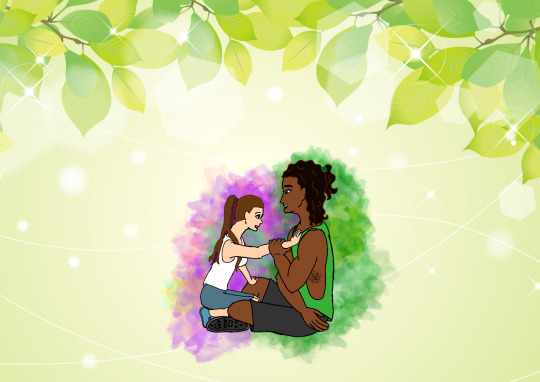
“Here. Hold [your hand] here. On my chest…
…
“I’ve never felt a Freelancer’s magic like this…”
Okay! I drew Huxley and Freelancer’s bridging from Huxley’s confession audio. And I loved it so much but didn’t know what to do with the background. So here. Have all the versions lol
This one doesn’t have a single line traced for their poses. Which is why the hands suck but I am so proud of how it turned out!
Huge thanks to @zozo-01 and @palilious for their encouragement (and for Pali’s influence on me changing how I draw Huxley—love you Pali!)
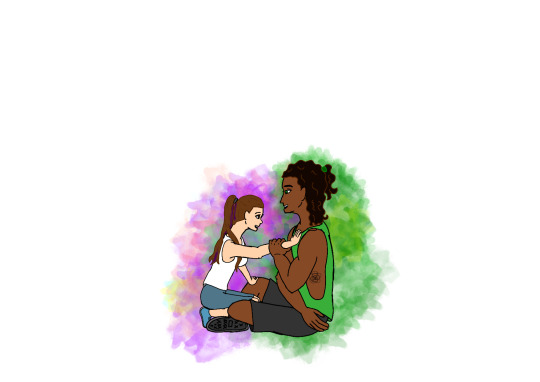
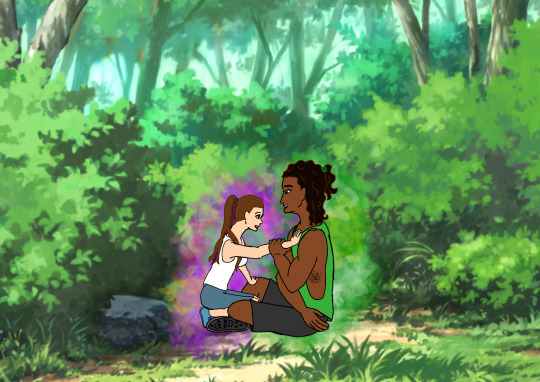
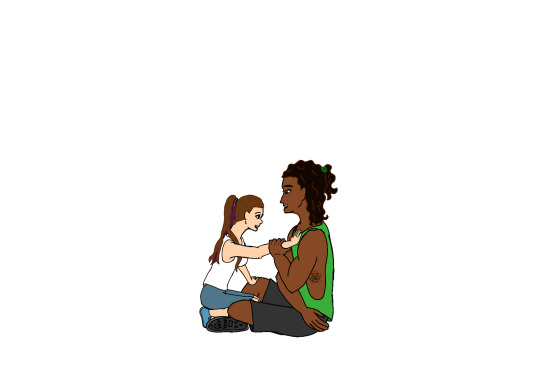
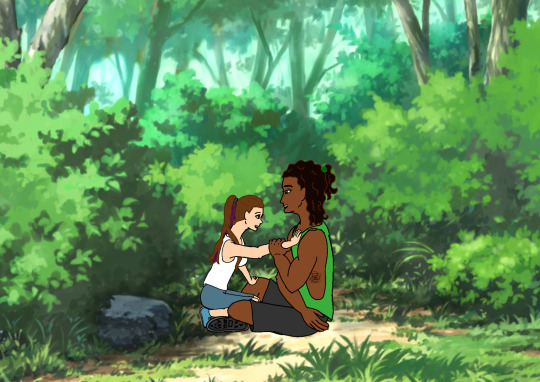
#Redacted Audio#Redacted Audio fanart#Redacted Huxley#Redacted Freelancer#Starlit Art#Huxley#Freelancer
26 notes
·
View notes
Text
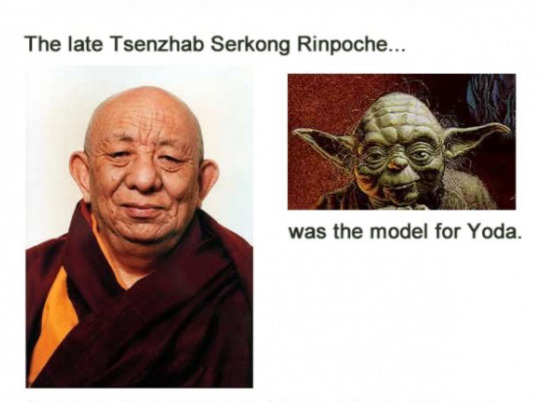
Yoda: A Buddhist-Inspired Character in the Star Wars Universe
Buddhist type quotes and teachings “Fear leads to anger, anger leads to hate, hate leads to suffering.” YodaThe Jedi Order of celibate knights base their lives on such things as mindfulness, serenity, and the mysterious “Force”. Not unlike the celibate forest monks of Thailand, if one replaces the “Force” with the Dhamma. There are also the obvious similarities to the Samurai who vehemently adopted Zen."You must unlearn what you have learned."“Nothing more will I teach you today. Clear your mind of questions.” (Similar to the preparation for meditation, clearing the mind to focus on the breath, sensations, etc.)At one point Luke enters a cave for meditation to confront his demons and then states:Luke Skywalker: “What’s in there?”Yoda: “Only what you take with you.”Luke Skywalker: “But how am I to know the good side from the bad?”Yoda: "You will know. When you are calm, at peace. Passive.”And one of the best quotes by Yoda:“Try not! Do, or do not. There is no try.” (Similar to the Zen concept of succeeding or feeling as if you will face death used in sports, etc.)
Yoda, the iconic character from the Star Wars universe, has captured the hearts and minds of fans worldwide with his wisdom, teachings, and unique personality. While not explicitly defined as a Buddhist, Yoda's character exhibits striking similarities to the philosophies and practices of Buddhism, particularly Zen Buddhism and the way of the Samurai. This essay explores the Buddhist basis of Yoda's character, his quotes and teachings reminiscent of Buddhist principles, and the intriguing connection between his name and the Pali word 'Yodha.'
1. Image, Buddhist Basis of Yoda:
The visual basis for Yoda's character is said to have been inspired by the Rinpoche Tsenzhab Sekong, a debate partner of the Dalai Lama. This connection implies a link between Yoda and Tibetan Buddhism, adding depth to his character's potential Buddhist influence.
2. Buddhist Type Quotes and Teachings:
Yoda's quotes and teachings in the Star Wars series reflect profound Buddhist-like principles:
- "Fear leads to anger, anger leads to hate, hate leads to suffering." This quote emphasizes the destructive cycle of negative emotions, echoing the Buddhist concept of suffering arising from attachment and aversion.
- The Jedi Order's focus on mindfulness, serenity, and the Force parallels Buddhist ideals of mindfulness, meditation, and the Dhamma (teachings). The Force can be likened to the Dhamma, a source of wisdom and guidance.
- Yoda's instruction to "unlearn what you have learned" aligns with the Buddhist concept of emptying the mind of preconceived notions to attain true understanding.
- When Yoda advises, "Clear your mind of questions," it mirrors the preparatory process for meditation, where one clears the mind to focus on the present moment.
- Yoda's guidance to Luke Skywalker to "try not! Do, or do not. There is no try" echoes the Zen concept of wholehearted commitment and the absence of doubt in one's actions, similar to the approach of Samurai warriors.
3. The Name Yoda:
The name Yoda bears a fascinating resemblance to the Pali word 'Yodha,' which means 'soldier.' Yoda's character exhibits qualities of a Samurai master (Jedi) who is both a philosopher and teacher. This connection between his name and 'Yodha' underscores his role as a wise and disciplined warrior.
Yoda, as a character in the Star Wars universe, embodies the essence of wisdom, inner peace, and the pursuit of balance, reminiscent of Buddhist and Zen teachings. The alignment of his character with principles found in Buddhism and the connection between his name and the Pali word 'Yodha' highlights the depth of his character's inspiration. Yoda's enduring popularity is a testament to the universal appeal of these timeless spiritual and philosophical values present in his character.
#buddha#buddhism#buddhist#dharma#sangha#mahayana#zen#milarepa#tibetan buddhism#thich nhat hanh#padmasambhava#inner peace#four noble truths#tantra#green tara#dalai láma#dhamma#Dzogchen#Dilgo Khyentse Rinpoche#loving kindness#Longchenpa#Bodhisattva#buddha samantabhadra#Guru Rinpoche
6 notes
·
View notes
Note
Happy STS I hope I'm doing this right!
What has been some of your biggest inspirations for writing?
Hi, thanks for the ask and happy STS to you too! (And don't worry, there is no right way to do those asks! You are doing just fine!)
My inspiration comes from a mix of media I consume. For TSOU I think I was really influenced by Genshin Impact, I was constantly palying it while I thought up the concept for this wip, and a lot of things were born out of admiration for the game. Some landscapes I envisioned, the idea of making 5 different islands and gods. My goal would be to achieve a worldbuilding of the kind used in genshin too: it makes you wonder, and makes things feel real and magical at the same time.
#creative writing#writing#writeblr#sts#sts ask#storytelling saturday#ask answered#my work#author's work
4 notes
·
View notes
Text
palisade 22. kind of a mess of notes about that haunted moon
NOTES
"Mosaic Gyratory"
gravity changes ("like the wind changes direction", uneasy/sickening feeling. I only just realized this makes sense re: Austin talking about the tides rising when the Chimera's Lantern did [????] last time to help people fight off the Divine Principality. that is how those work)
murals of divines (immediately thought of the divine fleet. i just don't know how it fits if at all???. i guess the question would be divine fleet from when? from when (partial) palisade & co left?)
animal components in the structure (next to ceramic etc. there's also normal stuff): bone, vast insect shells (the insect shells made me think of signet&belgard immediately but its not like they have the. whats the word. theyre not the only ones that can be buglike or have buglike stuff.)
teeth beasts. teeth instead of muscle or flesh. teeth… (hm. hm. hm. yeah i dont know. hm. btw when i read 'description of teeth' in the content warnings i was a bit puzzled by it but then i went aahhhh i see when these things showed up.)
blue-ish glow / white-orange glow (2 different glows in different directions = different sources? Also i only remember austin describing the orange glow when talking about Chimera's Lantern weirdness, but not the blue one. Possible the blue is new/related to Nideo being there now?)
THOUGHTS re: mural of divines
i was trying to find something twilight mirage and specifically signet related but i keep just reading bits of transcripts and going man tm was so fucking good huh
anyways i found it and i thought of…. the crypt of the order from signets playbook. now. in retrospect im actually fairly sure it just came to mind because sylvi earlier in the ep mentioned the roman saints as a reference for coris new mech + the divine fleet connection i made (it's the murals. in my head that's just. it has Got to be related.) = crypt of dead excerpts & their things (the scene I'm talking about in TM18 is honestly one that makes me really sad about signet. man. signet). I don't know...
WHAT'S UP WITH THIS THEN
it cant just be A Divine. that's not it. But the way... it's talked about Sounds so. Divine Influence. does it not?
"It’s often about letting people determine the best versions of themselves. People are— the warriors of the moon are kind of described as having their natural capabilities enhanced. There’s a lot of verbiage that combines expression, like the idea of self expression and becoming a version of yourself that you want to be, with a sort of epic heroism."
"It gave them— the way that it’s written about here, the way that Crystal Palace saw it was that these are people who were raised with the light of justice and were raised as defenders against an empire vast in the future. They were trying to— they’re people who were trying to prune something that would take over, that would grow over the galaxy." (PAL15: Upon Our Grace Pt.2)
(Honestly interesting to bring that up there as a metaphor, since we have… you know, it's not a field it's a garden (TM), and now in PALISADE:
"I think one of the new Gur Sevraq’s most famous sermons is about how the galaxy in general, and Palisade specifically, isn't meant to be a jungle, or an overgrown field, it's meant to be a garden, you know? It's well-groomed, it's supposed to be maintained. You're supposed to attend to the world." (PAL01: Into The World Pt. 1)
that just as an aside though. i noticed it and wanted to note it.)
oh my god the divine cycle timeline is so fucked i cannot make sense of it once i try to think about details i just cant.hell on earth 6 wiki pages and 9 transcripts open. i keep getting shit confused "Everything that has happened before will happen again." i fucking know right
sorry i was trying to find Divine Fleet info from PRE-twilight mirage. and ended up just looking up the partial palisade stuff, which, they left when under attack from the NEH. ok. I just don't know... at what point did Palisade "die"... When did the Divines turn into Afflictions (they HAVE NEH names, so... after or during a time when the NEH was attacking Palisade? does this make sense?)? I'm lost. I got lost. Why am I asking myself this again. OH RIGHT
post by swallowtailed i just saw bc i looked up chimeras lantern on here talked about the moon being part of the planet (there's quite a big part missing up with that cauldron). I guess in my mind... a big part of the planet being blown(?) off or otherwise removed somehow COULD very well be related to a divine turned living planet dying. right? post also mentioned it being a tomb for his excerpt which funnily enough lines up with my crypt thought from earlier. and it IS a question on what happened to those god i just wanna know whats up with the afflictions!!!! not what this post is about though so im stopping.
it's all just so. i think it's in an episode without transcript yet and i don't feel like hunting for it but when austin implied that whatever is happening with the moon is as or more important for the world as. the WORLD BLOWING UP? its haunting me
#palisadeposting#this isnt getting more coherent rn also i want to take my walk.#ok i tried to like. put it in sections... at the very least...#i get sidetracked soooo easily#anyways.my walk (c/w ep 6 now)#palisade spoilers
3 notes
·
View notes
Text
more kel dor conlang translation! was very tempted to try and put this into mando'a too for comparison's sake but I'm stuck on the grammar a bit lol
yenin di ka tsakao de konati ksoli a yaduraiyi kya?
jjenao le parsidai kare a koegoe jjakaviki di
paliyeh yajje neorro nazadizi ge
egen di zaki tooyaditta ka naa
the english version is this:
what can you defend by lying?
there's no shame in falling to your knees
just always make sure to stand back up
so we can see each other again
yenin = question word, 'what'; from nin, meaning 'stuff, things'.
tsakao de konati = to lie, to speak deliberate falsehood; tsakao de is sometimes used on its own as an expletive along the lines of 'bullshit!'
ksoli a = instrumental plus secondary focus particles; kinda emphasises the instrumental.
yaduraiyi = passive form of yaduri, to defend, used when the focus is what's being defended rather than who does the defending. The verb in the song I'm translating was originally passive-form, but the english translation made it active form. (i guess bc passive constructions in english sound a lot weaker? maybe?) Passive form in keldeorinyaa hasn't got the same vibe, so I went back to it lol.
jjenao = legs, feet, knees sort of included by default? The construction here, jjenao le parsidai, literally means 'collapse only legs', but it's used in pretty much the same way you'd use 'fall to your knees' in English. keldeorinyaa does have a word for knees, but it sounds very clinical -- zangettamak.
kare a = a form of qualitative particle used for actions and processes, plus the secondary focus particle.
jjakaviki = shame, embarrassment, much stronger connotations of moral weakness than in english - only applied in circumstances your actions could reasonably influence.
kel dor culture historically dealt with so much hardship and suffering as a result of just. living on Giant Storm Hellworld lmao that they still kind of default to assuming that a certain amount of struggle and bad luck and failure and whatnot will just be a part of everyone's lives. Suffering isn't special, it's not sacred, but it also is never assumed to occur because you did something to make it happen. That goes double for significant suffering. Nobody's gonna judge you for getting struck by lightning, bc that shit just happens semifrequently on Dorin lmao
paliyeh = ongoing form of pali, to stand.
yajje = referential particle, in this case referencing an ideal. Sometimes can be literally translated as 'in regards to', but is quite a flexible particle.
neorro = frequency quantifier, means always, ongoing, or permanent depending on context.
nazadizi = habitual form of nazadi, to act with intent; in this case it's 'confirm' or 'make sure of it'. Used with the ge imperative mood.
zaki = purpose particle; there's a reason for doing things here.
tooyaditta ka = to meet (future certain form) plus the practical ka mood; 'able to meet once more'. Followed by the naa emphatic particle.
#kel dor conlang#for some reason this post rly fucked up one browser tab lmao#so glad posts save drafts automatically these days lol
2 notes
·
View notes
Photo
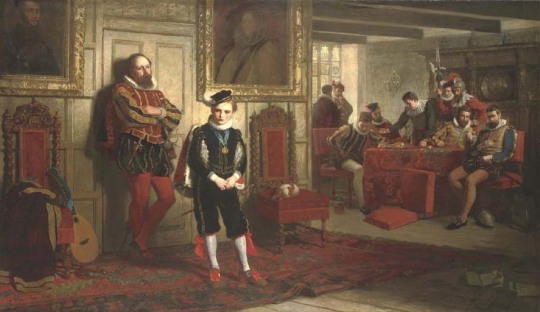
On June 27th 1583 James VI escaped from Ruthven Castle to St Andrews Castle.
This is, to me is always one of the strangest occurrences in Scottish Royal history. Now called Huntingtower Castle, Ruthven was, as you would maybe expect Lord Ruthven, who also went by the name the Earl of Gowrie.
Apparently this had to do with The Protestant Lords getting worried about those pesky Catholics getting to paly with the young King, one in particular was Esmé Stewart who was his second cousin and part of the Franco-Scot arm of the family. Esmé arrived Scotland just as James was about about to reach his majority, that is the age in which he would rule in his own right, until then he had Regents rule in his name and they often quarrelled and jostled schemed for their own aims.
The Scottish diplomat and memoir writer, James Melville described Esmé as “of nature, upright, just, and gentle”. Given James’s penchant for men,( it has been written he was gay, or at least bisexual), this exoctic visitor from France soon became a firm favourite with 13 year old King. Less than a year after arriving James made gave Esmé the title Earl of Lennox and in 1581 further bestowed him with the name Duke of Lennox.
Of course in a post reformation Scotland ruled by Protestants a Catholic with titles such as these pissed them off a wee bit. In the end Esmé had to make a choice, his religion or his friendship with James, he chose the King. The Scottish Kirk remained suspicious of Lennox after his public conversion, and took alarm when he had the Earl of Morton tried and beheaded on charges of treason, for the murder of his first cousin and Jame’s father Lord Darnley.
Scottish Calvinists began to noticed the physical displays of affection between him and the king and alleged that Lennox “went about to draw the King to carnal lust” While James had disposed of his Regents and was now ruling, something had to be done.
In August 1582, in what became known as the Ruthven Raid, the Protestant earls of Gowrie and Angus lured James into Ruthven Castle, imprisoned him and forced Lennox to leave Scotland. During James’s imprisonment , John Craig, whom the king had personally appointed Royal Chaplain in 1579, rebuked him so sharply from the pulpit for having issued a proclamation so offensive to the clergy “that the king wept” to which the Earl of Gowrie responded “Tis better that bairns weep than bearded men!”
This next part was in my eyes strange, even though he was a prisoner James kept a secret correspondence with Esmé, who the Lords expected him to show he was falsely converting to fool the King, on the contrary the former duke remained a Presbyterian and died May 1583. I would have loved to have found a more sinister cause of death, but all I could muster was natural causes.
His final letter was to James Stewart, Lord Doune, requests that Lord Doune take care of his son and to recover for him Esmé’s possessions in Scotland. His heart was taken beck to James in Scotland and his wife and son Ludovic came to Scotland. James had repeatedly vouched for Lennox’s religious sincerity and wrote of him in a poem called “Ane Tragedie of the Phoenix”, which compared him to an exotic bird of unique beauty killed by envy.
James regarded all Lennox’s family with great affection, and instructed his son Charles I to do well by them. Charles faithfully fulfilled this obligation, and as a result the Lennox family had considerable influence at the English Court over the next two generations.
The King’s captivity came to an end in June 1583, when he escaped while on a visit to St Andrews. The Ruthven conspirators were in turn banished from the kingdom. The Earl of Gowrie was shortly afterwards pardoned and allowed to return, but after involving himself in further plotting, was executed in May 1584.
The photo is a 19 century depiction of James and his captors by Scottish artist William Baxter Collier Fyfe
19 notes
·
View notes
Text
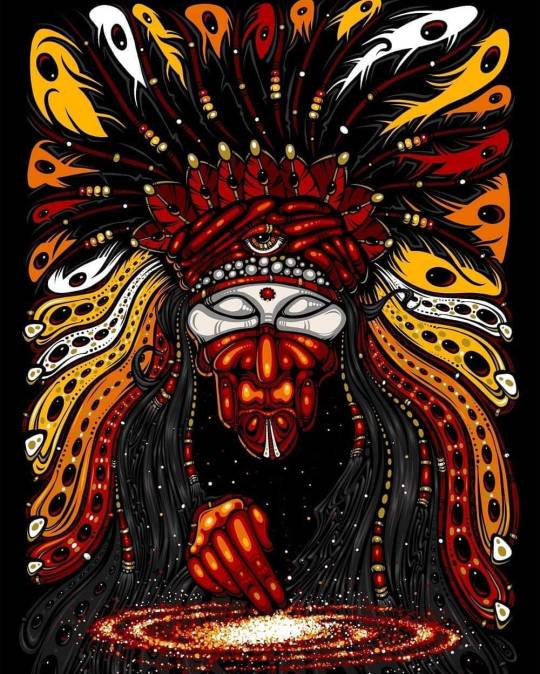
The Figure of the Shaman
Of all the diverse religious institutions that humans have elaborated since before the beginning of recorded history, that of shamanism is one of the most singular and is probably one of the most archaic as well. The shaman is something of a maverick among religious practitioners. While shamanism occurs in virtually every culture on the planet, manifesting itself in religious traditions both ancient and modern, both primitive and sophisticated, the shaman remains eminently individualistic, idiosyncratic, and enigmatic, standing ever apart from organized ecclesiastical institutions while still performing important functions for the psychic and religious life of the culture. Comparable, but not identical, with such similar idiosyncratic practitioners as medicine men and sorcerers, the shaman is the possessor of techniques of proven efficacy and of powers bordering on the paranormal, the complete understanding of which still eludes modern psychology.
The word shaman is derived from the Tungusic term saman, derived in its turn from the Pali samana, indicating a possibly Southern (Buddhist) influence among these northern peoples (Eliade, 1964). Eliade distinguishes the shaman from other types of religious and magical practitioners primarily on the basis of his religious function and techniques: ... he is believed to cure, like all doctors, and to perform miracles of the fakir, like all magicians, whether primitive or modern. But beyond this, he is a psychopomp, and he may also be priest, mystic, and poet. He further defines the shaman as a manipulator of the sacred, whose main function is to induce ecstasy in a society where ecstasy is the prime religious experience. Thus, the shaman is a master of ecstasy, and the art of shamanizing is a technique of ecstasy.
Artwork by Jeff Wood
9 notes
·
View notes